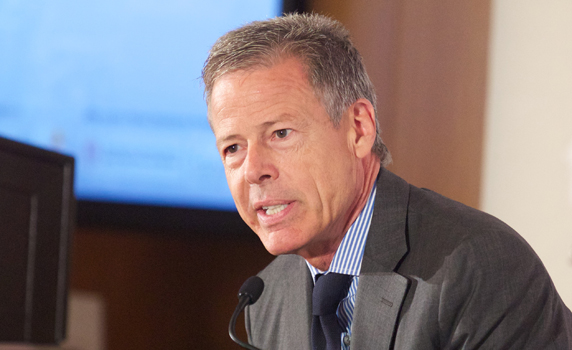
Securing audience loyalty and advertising investment is a constant challenge for the media industry, and has been made more complicated by today’s digital reality – a viewer is able to access seemingly endless content, at any time, on a number of devices. Finding opportunity in this rapidly shifting media landscape was the subject of the morning session of the 1st Media & Entertainment Industry Forum, an all-day conference held on July 1st at IESE’s New York center.
The meeting featured insights and forecasts from top level media executives. Their thoughts were prompted by William F. Baker, President Emeritus Thirteen/WNET and an IESE professor, and Gerry Byrne, Vice Chairman of Penske Media Corporation (PMC).
Capturing your audience
David Poltrack, Chief Research Officer, CBS Corporation and President of CBS VISION, expressed an optimistic view of the future of television and the "tremendous expansion of opportunity." For example, viewers now have 100 percent access to a program through on demand and streaming as opposed to 33 percent access in the traditional linear format. Poltrack supplied further evidence to bolster his sunny outlook. Although live television viewing declined from 89% to 80% between 2011 and 2014, overall television viewing increased 2%. Two thirds of the viewing population is connected through a second device, providing instant access to products.
Viewers usingstreaming services have grown significantly, especially among the young. With 25 percent of the viewing audience using streaming, the advantage, Poltrack says, is that you can "run a full complement of ads" that can’t be bypassed. In fact, this demographic spends more advertising dollars than traditional television viewers.
Tom Rogers, CEO of TiVo, said that a survey of users of this technology revealed that 90% admitted to "binge viewing." He noted that binging is much more "natural to the story line" and sees an advertiser benefit in the opportunity to craft a relationship with that audience that "doesn’t get in the middle but takes advantage of eyeballs fixated."
The 24 percent of television viewers known as "media trendsetters" are the ones to target because of their social influence and 33 percent higher spending than the rest of the population, says Poltrack. "You could take "media" off and just call them ‘trendsetters’" because of how they drive industry innovation by sharing their opinions online and through word of mouth. To inspire viewers to talk about your programming, the focus must be on the emotional element the audience is seeking – whether it’s the thrill of the game, an inspirational message, or intellectually stimulating content. Social media influencers, including these trendsetters, "program passionates," and "engaged streamers," represent tremendous opportunities for advertising revenue both today and in the future.
Challenges and Opportunities
Juan Pujadas, Global Vice Chairman of Advisory Services, PwC International, presented the trends from the company’s Global Entertainment and Media Outlook. According to this report, in the next few years we will see:
- nine markets driving media industry growth – China, Brazil, Russia, India, Mexico, South Africa, Turkey, Argentina and Indonesia;
- internet advertising reaching a "tipping point" and exceeding all other categories combined;
- an ongoing challenge of monetizing digital consumerism;
- licensing, cybersecurity, and data protection challenges that have emerged as the film entertainment industry transitions to outside the United States and the United Kingdom.
Paul Marcum, Head of Global Digital Innovation, Bloomberg, sees growth opportunity in multiple areas, including a foray into the political sphere. His optimism stems from a belief in audience loyalty. "You want those who share your sensibilities in this incredibly noisy news environment to succeed…how we grow and foster that is crucial to our success." Byrne agreed that "audiences want a perspective from an environment they trust." Marcum also spoke of the importance of seeking out distribution partnerships and leveraging them in order to maintain relevance.
Although TiVo began as a disruptor to traditional television, Rogers spoke of a philosophy of "weaving the company into the fabric of the television industry," and focusing on helping industry incumbents "rather than undermining their business model." He believes that television "is so far behind the eight ball when it comes to user experience." Rogers looks to the transformation of the music industry as a model, with TiVo’s success stemming from flexibility and "creating a user experience that makes for ease and convenience." As for advertising potential, Rogers sees the television interface as an ideal opportunity to "profit from the immediacy of response."
Looking to the Future
According to Time Warner Inc.’s Chairman and CEO, Jeff Bewkes, we are experiencing the "golden age of video programming." He claims viewership is going up around the world ("online viewing IS television") and attributes the increase to the quality of the programming and appreciation for on-demand viewing. Budgets are increasing, as is network profitability. With one third of the company’s revenues generated overseas, Bewkes keeps an eye on the enormous growth of the film business in China and Russia.
Poltrack believes there has been "more change in the past two years than in the previous 20," and views this in a positive light. As Byrne affirmed, "the landscape has changed but the audience is still there."
The afternoon session consisted of two high-profile panels on the controversial issue of Net Neutrality and its implications for internet users and content creators.